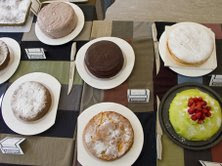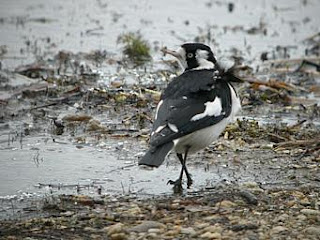Years ago I bought Michael a novel purely on the strength of its first line: "I am a journalist of the old school; in other words, an alcoholic." Title and author are lost in the mists of time, but these words (approximate, of course) have stuck with me.
I was reminded of them today when I attended the Fleet Street funeral of a journalist friend. She wasn't much of a drinker herself, but at almost 91 years old, she'd met quite a few in her time who were. I'll miss Eileen's wonderful stories of her strange adoptive parents, her flight from their wealthy but loveless home in her teens, the war years she spent dodging marriage offers until she succumbed to the charms of a Yank. He turned out not to be the love of her life. Sadly the man who was died in a plane crash shortly after their engagement in the 1970s. He worked with Walter Cronkite — whom Eileen outlived by two weeks. I'll paste below the brief biography of Eileen Vincent Summers that appeared on the Chartered Institute of Journalists website.
The memorial service was held in
St Bride's Church on Fleet Street, the spiritual home for even non-believing British journalists. A crowd of about twenty gathered to say good-bye to this tiny, feisty woman who stayed sharp as a tack even in her final days. Right before we left for France in July, she asked me to print out and mail internet material on her condition so that she could make sure her doctors knew what they were talking about. She had to postpone a planned museum-visit-plus-lunch that we had scheduled: I had CALL EILEEN written in big letters on this week's page in my calendar, since she was sure she'd have the medical profession sorted out by the time I got back. Not to be.
I'll also include at the end a few historical facts for you, Dad, on St Bride's. It's one of the famous Wren churches of London. Or was--only its magnificent steeple (which inspired the design for tiered wedding cakes) was left after the Blitz. It has now been rebuilt quite faithfully and the bombs did uncover Roman walls in the crypt area. This is where the service was held. Afterwards, the group settled into the El Vino wine bar, long a hangout for thirsty journalists. I finally met her good friend Pam Smith, about my age, who has kept all Eileen's acquaintances in the loop during this last illness. She was a delight, and I'm hoping she and her equally delightful husband Brian will join us soon for a trip to Borough Market and lunch at the flat, where we'll lift our glasses to the indomitable woman who brought us together. Pam has promised to copy a photo of Eileen she found when sorting through her papers that I'll put at the start of this post.
I was a short-term, peripheral person in Eileen's life: we met a couple of years ago when she was taking notes for a short article at a PEN panel discussion Michael participated in. Pam, however, who also lived in Egham, was the sort of friend a single, childless older woman is very, very lucky to find. Despite being immaculately and stylishly dressed every time I saw her, Eileen had limited funds and it gradually became clear to me that she relied on Pam to sort out the administrative hassles that arise when you live on a restricted budget and can't simply throw money at problems. Another longtime friend at the memorial service was Linda, a decades-younger American who had known Eileen since their New York days. Although based in Chicago, Linda teaches drama in Oxford every summer, her annual arrival always eagerly anticipated. It was Linda's friend John who read the passage from Eliot's "Little Gidding" during the service, including these words:
What we call the beginning is often the end
And to make an end is to make a beginning.
The end is where we start from . . . . We die with the dying:
See, they depart, and we go with them.
We are born with the dead:
See, they return, and bring us with them.
The moment of the rose and the moment of the yew-tree
Are of equal duration . . . .
We shall not cease from exploration
And the end of all our exploring
Will be to arrive where we started
And know the place for the first time.
One more small note: communion was offered, but the bishop has decreed that no wine is now served, just bread. This isn't a reflection on journalists, but a sign of the times. Even consecrated wine doesn't kill swine flu germs.
Eileen Vincent Summers
Eileen was born in London on August 4, 1918 and died on August 1, 2009 – three days short of her 91st birthday.
Eileen was adopted by a couple named Arthur and Lizzie Gladman, who had lost their only son in the Battle of the Somme. Throughout her life she tried to find answers to the details of her real family and origins, but despite her efforts, she was unsuccessful. All records had been destroyed.
Eileen was a writer and a working journalist all her life. This is a quote from a letter Eileen wrote to ‘The Journal’ of the Chartered Institute of Journalists.
“I was particularly taken by Phillip Paul’s recollection of his days and nights as a cub reporter with the Salisbury Journal. I too was a trainee reporter at about the same period, with his competition The Salisbury Times for fourteen months and then for a couple of months of World War II.” Describing her early days as a cub reporter she wrote: “When the editor discovered that not only could I write, I could spell, he let me loose on every type of assignment. From Yehudi Menuhin at the cathedral to inquests, courts martial, police courts and City Council. I had a ball.”
After the war, Eileen married an American, Thomas Summers, and moved to Palo Alto, California, where she became a staff-writer for the local paper. There were long periods when she lived in Europe where her husband had a diplomatic post.
Divorced, after eighteen years of marriage, Eileen returned to the United States where she went to work for The Washington Post as a staff writer. After six years in Washington, she moved to New York where she was an editorial writer for the CBS all-news flagship radio station in New York and then writer/researcher with the Elections Unit of NBC Television.
While working in New York, Eileen fell in love and was engaged to marry John Merriman, the Managing Editor of the CBS Evening News with Walter Cronkite. Tragically he was killed in an airplane crash in 1974 shortly before their marriage.
In a verse from a poem written after John Merriman’s death, Eileen wrote:
“Don’t tell me that you know just how I feel.
Has death for you, with one swift blow
Become quite real?
Does your true love lie dead?
If this is so,
Then yes, you know
Just how I feel.”
After John’s death, Eileen returned to England and went to work for The Oxford Times. She then settled in Egham, Surrey, working as a free-lance journalist. At the same time, she joined the Chartered Institute of Journalists and became a long-serving committee member of the Freelance Division and Trustee of Institute charities. She leaves a collection of plays, short stories, book reviews and poems.
St Bride's Church (from the website linked above):
American Connections
As the home of printing, St Bride's position has always been an international one. However, its connections with America are particularly strong. On 18th August 1585 the first American child of English descent was baptised Virginia Dare. She was the daughter of Elenor and Ananias who were formerly parishoners of St Bride's and were married in the church. A bust of Virginia stands above the font. On 4th November 1594 Edward Winslow, saltmaker of Droitwich, married Magdalen Ollyver in St Bride's. Their son, Edward, was born in 1595 and after schooling in Worcester he accompanied his father on trips to deliver sheepskins to printers and binders in and around Fleet Street. The register of The Worshipful Company of Stationers records his apprenticeship to John Beale and the young Edward worshipped at St. Bride's. Eventually he became one of the leading Pilgrim Fathers, setting sail on The Mayflower in September 1620.
Edward Winslow went on to hold the office of Governor of Plymouth, Massachusetts three times. He was also known as "America's first ambassador" as he returned to England several times on behalf of the colony.
From a tourist website:
St Bride's, dedicated to the sixth century Irish saint Bride or Bridget, is the parish church of the Press. The church is first mentioned in the records in the 12th century. In total, eight churches have occupied this site; the present building was restored in 1957 from Wren's original plans for the church of 1701, which was destroyed in the Second World War. The first printing press with commercial possibilities was brought to the churchyard of St Bride's in 1500 by Wynkyn de Worde, Caxton's assistant, and writers who wanted their work copied gathered in the area. Milton lived in the churchyard, Pepys was baptized here, Johnson lived across the road and Dickens lived up the road. Eventually, in 1785, the first national newspaper, the Daily Universal News - later The Times - was printed in Fleet Street.









 The story that lies behind 'stealing someone's thunder' is that of the literary critic and largely unsuccessful playwright, John Dennis. In 1704, Dennis's play Appius and Virginia was produced at the Drury Lane Theatre, London and he invented a new method of creating the sound of thunder for the production. We don't know now what this method was (some texts say it was a refinement of the mustard bowl referred to by Pope, in which metal balls were rolled around in a wooden bowl), but it is reported that after Appius and Virginia failed and was closed, the method was soon afterwards used in a production of Macbeth. Dennis was less than pleased at having his idea purloined and this account of his response was recorded by the literary scholar Joseph Spence (1699–1768) and later quoted in W. S. Walsh's Literary Curiosities, 1893:
The story that lies behind 'stealing someone's thunder' is that of the literary critic and largely unsuccessful playwright, John Dennis. In 1704, Dennis's play Appius and Virginia was produced at the Drury Lane Theatre, London and he invented a new method of creating the sound of thunder for the production. We don't know now what this method was (some texts say it was a refinement of the mustard bowl referred to by Pope, in which metal balls were rolled around in a wooden bowl), but it is reported that after Appius and Virginia failed and was closed, the method was soon afterwards used in a production of Macbeth. Dennis was less than pleased at having his idea purloined and this account of his response was recorded by the literary scholar Joseph Spence (1699–1768) and later quoted in W. S. Walsh's Literary Curiosities, 1893:


